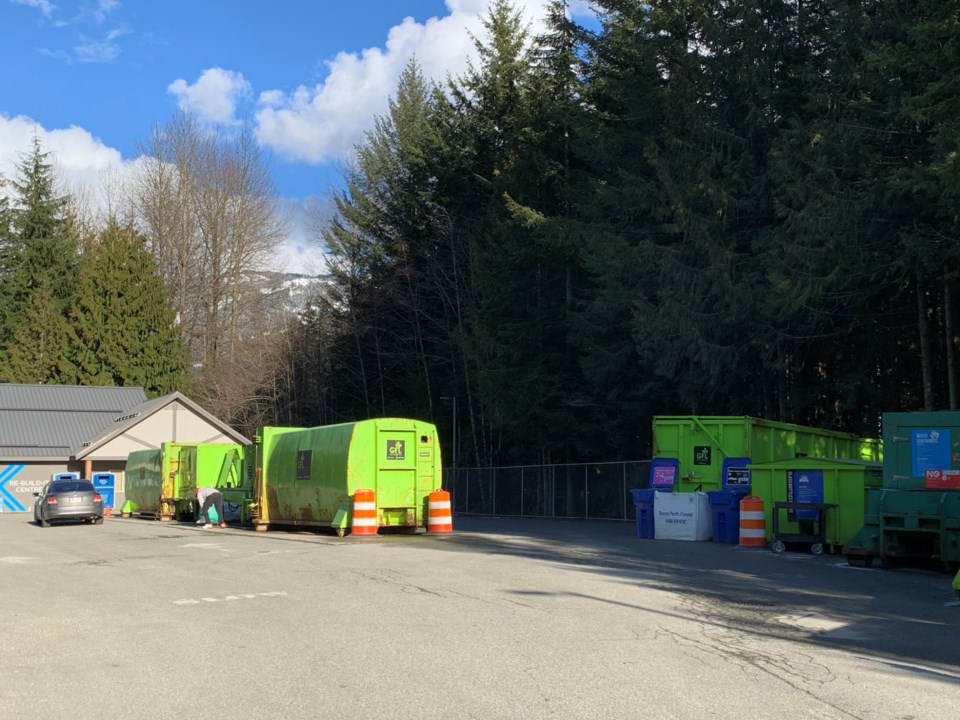In 2021, the Resort Municipality of Whistler (RMOW) endorsed its Zero Waste Action Plan, setting the ambitious goal of decreasing the amount of landfill waste produced in Whistler by 80 per cent from 2019 levels by 2030. On April. 3, Whistler’s mayor and council received a report showing progress towards that goal—although the community still has its work cut out for it.
According to municipal solid waste technician Lauren Harrison, over the last year, significant progress has been made in reducing the amount of landfill waste created in the municipality, despite Whistler’s rising population. It is, however, still miles away from its 2030 target, which would require the resort to reduce the 11,841 tonnes of landfill waste generated in 2019 down to 2,368 tonnes in the next seven years.
“We have a long way to go, but we are consistently moving in the right direction,” Harrison said in her presentation to council. ‘
In 2022, Whistler produced 11,432 tonnes of landfill waste, 73.7 per cent of which came from commercial and strata properties, 14.5 per cent from the construction and demolition sector, and the remaining 11.8 per cent from the Nesters and Function Junction transfer depots.
Whistler compares well per capita to the 2020 provincial average, producing 318 kilograms of waste per person, compared to the province-wide average of 499 kg/person (provincial figures have not been released for 2021 and 2022).
“It was really great to see that in 2022 there wasn’t much of an increase compared to 2020 and 2021, and that’s awesome to see because our population and visitor numbers were much higher this year,” Harrison said.
Overall, the municipality is trending in the right direction, with landfill waste increasing by a relatively small amount from 2021 levels and down from the high of roughly 17,000 tonnes seen in 2009. The RMOW diverts about 47 per cent of all waste from the landfill, although this is down from the record 49-per-cent diversion rate achieved in 2021.
“This number’s been over 40 per cent since 2016, which is great, but we really need to look at how we can get this number even higher, and really we need to remove food waste from our landfill waste stream and get that going to organics, and that would significantly increase our diversion rate,” Harrison said.
[Editor’s Note: According to the RMOW’s community monitoring dashboard, Whistler has achieved a higher-than-40-per-cent diversion rate every year only since 2018, although it hit exactly 40 per cent in 2015, ’16, and ’17.)
While making notable progress, the waste audit at the residential transfer stations found that Whistlerites still have some work to do to reduce their own personal waste. Organic compostable materials comprised the single largest source of landfill waste by weight, accounting for 19.5 per cent of the total. However, this is down from 29 per cent in 2019, showing that more people are composting.
Non-organic compostable materials (mainly treated and painted wood) followed closely behind, at 18.4 per cent, with building materials (15.8 per cent), paper (14.8 per cent), and plastics (14.5 per cent) making up the majority of the rest.
The remaining percentage comprises metals, glass, hazardous materials, plastic bags, electronics, and other materials. The RMOW estimates that 47 per cent of this landfill waste could be diverted for recycling or composting.
Progress made on action items
Within the Zero Waste Action Plan, eight priority items have been identified as the most pressing to address, many of which have seen progress. These items include providing education and assistance to businesses to reduce waste, improving data collection, reducing food and demolition waste, and strengthening waste and diversion policies.
Some noteworthy advancements include creating a solid waste storage design guideline that helps inform developers and architects when designing communal waste rooms and creating a community monitoring dashboard to track the municipality’s metrics.
As well as the formation of a Demolition Waste Diversion Bylaw, which requires buildings to be deconstructed, not demolished, with more materials recycled, and the funding of a feasibility study on the creation of a reusable coffee cup program in the resort.
Councillor Arthur De Jong believes the amount of waste produced is morally unacceptable given the current state of the planet and the challenges brought on by climate change, but feels the reduction targets are achievable.
“Given what our Western society produces in waste and the related state of our collapsing planet, it is both frankly disgusting and morally unacceptable to produce the amount of waste that we collectively produce,” De Jong said.
“We all have a role in fixing this. An 80-per-cent reduction may feel like a moonshot, but I truly believe that if we’re all committed to the change, we could successfully land on this goal, but it is a very deep challenge.”





